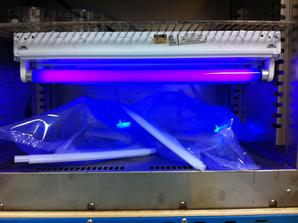By Kerri Jansen
STAFF REPORTER
Published: October 13, 2014 6:00 am ET
Updated: October 13, 2014 11:18 am ET

Image By: Johnson Controls Inc.
Johnson Controls Inc. testing for the ability of titanium dioxide to reduce VOCs includes heating up the parts to simulate real world exposure.
In an effort to improve interior air quality in the cars for which it supplies parts, the interiors division of Johnson Controls Inc. recently explored methods of reducing levels of volatile organic compounds (VOCs) in cabin air.
Troy Hendricks, manager of new technologies for the Technology & Advanced Development group at JCI’s Automotive Experience, tested the efficacy of titanium dioxide (TiO2) nanoparticles at eliminating VOCs, with an eye on capturing value for the Tier 1. He described his work at the Society of Plastics Engineers’ Automotive Composites Conference & Exhibition last month.
“We could sit and wait for a Tier 2 supplier, the adhesive people and the foam people, to get rid of the VOCs in their products,” Hendricks said. “We went to option two and tried to find a solution where we could capture value. And if we could create something that ate not just the VOCs from our part, but could eat VOCs from another part or absorb VOCs from another part, that would have some value to an [automaker].”
VOCs, the variety of gases partly responsible for the infamous “new car smell,” are emitted from certain interior finishes, resins, foams, adhesives and sealants. Extended exposure can have negative health effects including eye, nose and throat irritation, dizziness and headaches, according to the U.S. Environmental Protection Agency. In the U.S., automakers typically set limits for VOC emission in parts coming from suppliers.
VOCs dissipate naturally during the months after a part is manufactured. Estimating the time between a car’s manufacture and when it goes home with a consumer at about eight weeks, JCI’s goal was to reduce the VOC level before that point.
Hendricks started by conducting a series of tests to establish the baseline amount of VOCs released into a car interior. Since JCI doesn’t make a whole car with which to test emissions, he considered the VOC contributions of individual parts, such as a thermoset headliner. VOC emissions were measured by enclosing the material to be tested in a plastic bag, applying heat to accelerate the release of VOCs and collecting a sample of the vapors for analysis.
Hendricks tested individual components of the headliner as well as the composite. He found the amount of VOCs emitted from parts was not consistent, even between consecutive parts pulled off the manufacturing line, making it difficult to obtain a precise value for emissions.
“Sometimes we got as much as 85 percent variation for a certain VOC, and sometimes the raw goods would have a higher value than the composite” because heat from the manufacturing process drives out some VOCs, he said.
Hendricks also looked at existing literature to calculate initial levels of VOCs in a car and an estimated rate of dissipation.
Out of several compounds JCI has studied that react with VOCs, TiO2, a catalyst activated by ultraviolet light, was chosen for further testing. TiO2 is used in some construction materials to reduce airborne pollution and is able to reduce both main categories of VOCs relevant to the automotive industry: aromatics and aldehydes.
When TiO2 absorbs UV light, an electron is released. If there is water vapor present, a free radical can form. The free radical can then react with the VOCs, which are broken down into carbon dioxide and water.
Hendricks targeted headliners for the TiO2 treatment after determining headliners got enough light exposure to be reactive. And unlike seats or other interior components, the headliner is a large area that doesn’t receive a lot of contact from passengers. A coating of TiO2 nanoparticles – which is sprayed on as a liquid solution and then dried – is not visible on the headliner fabric.
Hendricks tested several formulations and binding methods to see which worked best. Using a bag as a reaction chamber to simulate a closed vehicle, he estimated the time it would take for TiO2 nanoparticles coated on a headliner to begin to reduce VOCs faster than they are being emitted in an average C-class vehicle’s cabin. He found the reaction rate is particularly sensitive to humidity, with the best rate measured at 27 percent relative humidity.
In ideal conditions, with optimal humidity and 12 hours of light per day, the period was calculated at seven weeks. But variations in conditions — less sun in winter, parking in a garage, a drier climate — could stretch the period as long as 120 weeks, a rate not fast enough for JCI’s purposes.
The project faced a key challenge in increasing the active surface area of TiO2 nanoparticles on the headliner. Adding more of the material resulted in clumping and not much improvement, Hendricks said. In fact, using 20 times more material only resulted in a rate increase of 20 percent.
“If we could get more of it down on the surface, [the rate] would increase, but part of the problem we found when I tried to increase the amount of coating was that it didn’t spread over the surface, it just made bigger lumps of titanium,” Hendricks said. “It’s kind of like oil and water — the oil will bead up, it doesn’t like to spread out into the water.”
The project is now under what JCI calls a “technology watch” until a more successful formulation of TiO2 can be identified.
JCI sold its headliners business earlier this year to an affiliate of private equity firm Atlas Holdings LLC, which operates the acquisition as Motus Integrated Technologies. | 